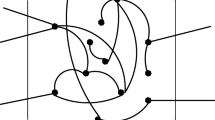Abstract
Counting CSPd is the counting constraint satisfaction problem (# CSP in short) restricted to the instances where every variable occurs a multiple of d times. This paper revisits tractable structures in # CSP and gives a complexity classification theorem for # CSPd with algebraic complex weights. The result unifies affine functions (stabilizer states in quantum information theory) and related variants such as the local affine functions, the discovery of which leads to all the recent progress on the complexity of Holant problems. The Holant is a framework that generalizes counting CSP. In the literature on Holant problems, weighted constraints are often expressed as tensors (vectors) such that projections and linear transformations help analyze the structure. This paper gives an example showing that different classes of constraints distinguished by these algebraic operations may share the same closure property.
Similar content being viewed by others
Notes
In [4], a stronger condition called the Block Orthogonality is imposed on the set \(\mathcal {W}_{\mathcal {F}}\), but the algorithmic part of dichotomy only requires orthogonality. As we will see in Section 2, violation of the Orthogonality condition implies # P-hardness, which is proved by using the notion of block orthogonality.
For technical reasons, we require finite constraint languages in this paper. In fact, the equivalence also holds if we include equality functions of all arities.
References
Backens, M.: A New Holant Dichotomy Inspired by Quantum Computation. In: 44Th International Colloquium on Automata, Languages,And Programming, ICALP 2017, pp. 16:1–16:14. https://doi.org/10.4230/LIPIcs.ICALP.2017.16 (2017)
Backens, M.: A Complete Dichotomy for Complex-Valued Holantc. In: 45Th International Colloquium on Automata, Languages, and Programming, ICALP 2018, July 9-13, 2018, Prague, Czech Republic, pp. 12:1–12:14. https://doi.org/10.4230/LIPIcs.ICALP.2018.12 (2018)
Bulatov, A.A.: The complexity of the counting constraint satisfaction problem. J. ACM 60(5), 34 (2013). https://doi.org/10.1145/2528400
Cai, J.Y., Chen, X.: Complexity of counting CSP with complex weights. J. ACM 64(3), 19:1–19:39 (2017). https://doi.org/10.1145/2822891
Cai, J.Y., Chen, X., Lu, P.: Graph homomorphisms with complex values: A dichotomy theorem. SIAM J. Comput. 42(3), 934–1029 (2013). https://doi.org/10.1137/110840194
Cai, J.Y., Chen, X., Lu, P.: Nonnegative weighted #CSP: an effective complexity dichotomy. SIAM J. Comput. 45(6), 2177–2198 (2016). https://doi.org/10.1137/15m1032314
Cai, J.Y., Fu, Z., Guo, H., Williams, T.: A Holant Dichotomy: Is the FKT Algorithm Universal?. In: IEEE 56Th Annual Symposium on Foundations of Computer Science, pp. 1259–1276. https://doi.org/10.1109/focs.2015.81 (2015)
Cai, J.Y., Fu, Z., Shao, S.: From Holant to Quantum Entanglement and Back. In: 47Th International Colloquium on Automata, Languages, and Programming, ICALP 2020, July 8-11, 2020, Saarbru̇cken, Germany (Virtual Conference), pp. 22:1–22:16. https://doi.org/10.4230/LIPIcs.ICALP.2020.22 (2020)
Cai, J.Y., Guo, H., Williams, T.: The Complexity of Counting Edge Colorings and a Dichotomy for Some Higher Domain Holant Problems. In: 55Th IEEE Annual Symposium on Foundations of Computer Science, pp. 601–610. https://doi.org/10.1109/FOCS.2014.70 (2014)
Cai, J.Y., Guo, H., Williams, T.: A complete dichotomy rises from the capture of vanishing signatures. SIAM J. Comput. 45(5), 1671–1728 (2016). https://doi.org/10.1137/15m1049798
Cai, J.Y., Guo, H., Williams, T.: Clifford gates in the holant framework. Theor. Comput. Sci. 745, 163–171 (2018). https://doi.org/10.1016/j.tcs.2018.06.010
Cai, J.Y., Lu, P., Xia, M.: Holant problems and counting CSP. In: Proceedings of the 41st Annual ACM Symposium on Theory of Computing, pp. 715–724. https://doi.org/10.1145/1536414.1536511 (2009)
Cai, J.Y., Lu, P., Xia, M.: Dichotomy for Holant∗ problems with domain size 3. In: Proceedings of the Twenty-Fourth Annual ACM-SIAM Symposium on Discrete Algorithms, pp. 1278–1295. https://doi.org/10.1137/1.9781611973105.93 (2013)
Cai, J.Y., Lu, P., Xia, M.: The complexity of complex weighted Boolean #CSP. J. Comput. Syst. Sci. 80(1), 217–236 (2014). https://doi.org/10.1016/j.jcss.2013.07.003
Cai, J.Y., Lu, P., Xia, M.: Dichotomy for real Holantc problems (2018)
Dyer, M.E., Richerby, D.: An effective dichotomy for the counting constraint satisfaction problem. SIAM J. Comput. 42(3), 1245–1274 (2013). https://doi.org/10.1137/100811258
Goldberg, L.A., Grohe, M., Jerrum, M., Thurley, M.: A complexity dichotomy for partition functions with mixed signs. SIAM J. Comput. 39(7), 3336–3402 (2010). https://doi.org/10.1137/090757496
Huang, S., Lu, P.: A dichotomy for real weighted Holant problems. Comput. Complex. 25(1), 255–304 (2016). https://doi.org/10.1007/s00037-015-0118-3
Lin, J., Wang, H.: The complexity of Boolean Holant problems with nonnegative weights. SIAM J. Comput. 47(3), 798–828 (2018). https://doi.org/10.1137/17M113304X
Lovász, L.: Large Networks and Graph Limits, Colloquium Publications, vol. 60. American Mathematical Society. http://www.ams.org/bookstore-getitem/item=COLL-60 (2012)
Shao, S., Cai, J.Y.: A dichotomy for real Boolean Holant problems To appear at FOCS (2020)
Valiant, L.G.: Holographic algorithms. SIAM J. Comput. 37(5), 1565–1594 (2008). https://doi.org/10.1137/070682575
Acknowledgements
I would like to thank anonymous referees for their valuable comments and suggestions.
Author information
Authors and Affiliations
Corresponding author
Additional information
Publisher’s Note
Springer Nature remains neutral with regard to jurisdictional claims in published maps and institutional affiliations.
A preliminary version of this article appeared in the 12th Innovations in Theoretical Computer Science Conference (ITCS 2021). This work is supported by Science and Technology Innovation 2030 –“New Generation of Artificial Intelligence” Major Project No.(2018AAA0100903), NSFC grant 61932002, Program for Innovative Research Team of Shanghai University of Finance and Economics (IRTSHUFE) and the Fundamental Research Funds for the Central Universities.
Rights and permissions
About this article
Cite this article
Lin, J. The Complexity of Counting CSPd. Theory Comput Syst 66, 309–321 (2022). https://doi.org/10.1007/s00224-021-10060-x
Accepted:
Published:
Issue Date:
DOI: https://doi.org/10.1007/s00224-021-10060-x




